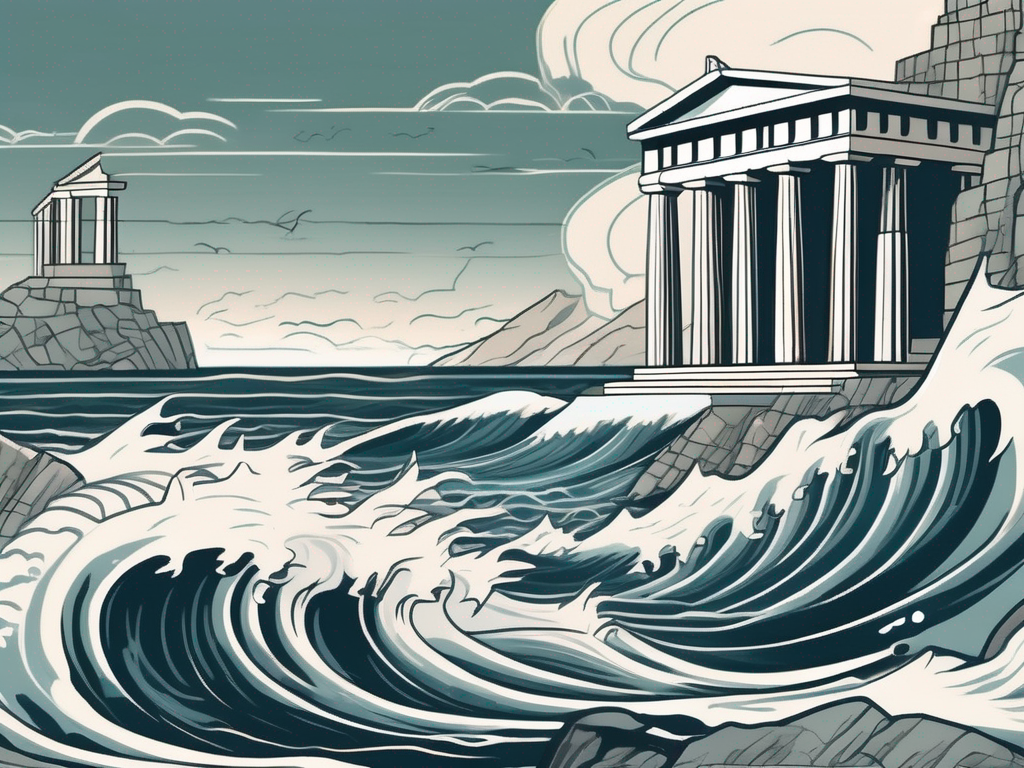When it comes to stories of miracles, few captivate our imagination quite like the account of Jesus walking on water. This extraordinary event, recorded in the Bible, has fascinated believers and skeptics alike for centuries. Let’s delve into the details of this miraculous event and its profound significance.
Understanding the Miracle: Jesus Walking on Water
Before we explore the miracle itself, it’s important to understand its context. The biblical account provides us with a detailed look at the event, shedding light on the theological interpretations that have shaped our understanding of it.
The story goes that Jesus’s disciples were sailing across the Sea of Galilee when a strong windstorm struck. Amidst the turbulent waves, they saw Jesus walking towards them on the water. Naturally, they were terrified, mistaking Him for a ghost. But Jesus reassured them, saying, “Take courage! It is I. Don’t be afraid.”
Upon hearing these comforting words, Peter, one of Jesus’s closest disciples, expressed his desire to join Him on the water. With Jesus’s permission, Peter stepped out of the boat and indeed walked on the water. The disciples watched in awe as Peter defied the laws of nature, his feet supported by the liquid surface beneath him. The sensation of walking on water must have been both exhilarating and surreal for Peter, a moment that would forever be etched in his memory.
However, when he noticed the strong winds, fear overwhelmed him, and he began to sink. The once miraculous act became a test of Peter’s faith. As he felt the water rise above his ankles, doubt crept into his mind. The wind howled around him, threatening to engulf him in its force. Panic set in, and Peter’s faith wavered.
Jesus immediately reached out His hand and saved Peter, saying, “You of little faith, why did you doubt?” With a firm grip, Jesus pulled Peter up from the depths of uncertainty and fear. The storm raged on, but in that moment, Peter experienced the unwavering strength of Jesus’s love and power.
This extraordinary event not only demonstrates Jesus’s divine power but also teaches us timeless lessons about faith, doubt, and trust in God’s provision. After all, how often do we find ourselves, like Peter, torn between the desire to trust and the fear of the unknown? In our own lives, we may face storms that threaten to overwhelm us, doubts that shake our faith, and winds of uncertainty that make us question our steps. Yet, just as Jesus reached out to Peter, He reaches out to us, reminding us to trust Him even when the waves crash around us.
Walking on water was not a mere spectacle for Jesus; it was a profound demonstration of His authority over the natural world and a testament to the depths of His love for His disciples. It was a moment that showcased the power of faith and the importance of keeping our eyes fixed on Jesus, even when the storms of life rage.
As we reflect on this miraculous event, let us remember that Jesus’s invitation to walk on water extends to each one of us. He calls us to step out of the safety of our comfort zones, to trust Him in the face of uncertainty, and to believe that with Him, we can do the impossible. May the story of Jesus walking on water inspire us to have unwavering faith, to conquer our doubts, and to embrace the miraculous possibilities that lie before us.
The Historical Context of the Miracle
Exploring the historical context surrounding this miracle can provide us with valuable insights into its significance within Jesus’s ministry and the broader cultural context of biblical times.
For Jesus, miracles were not merely displays of supernatural power but rather acts that revealed crucial aspects of His character and mission. They served as tangible signs of His authority and divinity, capturing the attention of the people and pointing towards the kingdom of God.
Moreover, water played a significant role in the religious and cultural practices of that time. It symbolized chaos, danger, and the unknown. So, when Jesus walked on water, He was not only demonstrating His power but also showing that He had dominion over the forces of chaos and fear.
In order to fully grasp the historical significance of this miracle, it is important to understand the socio-political climate of biblical times. During Jesus’s ministry, the region of Galilee was under Roman occupation. The Jewish people, who longed for liberation and the restoration of their kingdom, were living under the oppressive rule of a foreign power.
Against this backdrop, Jesus’s miracles took on a deeper meaning. They were not only acts of compassion and healing but also acts of resistance against the oppressive forces that held the Jewish people captive. Each miracle was a statement of defiance, challenging the status quo and offering a glimpse of the liberation that awaited those who believed in Him.
Furthermore, the miracle of Jesus walking on water can be seen as a powerful metaphor for the challenges faced by His followers. Just as the disciples found themselves in a boat, tossed by the waves and battered by the wind, believers throughout history have encountered their own storms of doubt, fear, and persecution.
By walking on water, Jesus showed His disciples and future generations that He is not only present in the midst of the storm but also has the power to calm the raging seas of life. This miracle serves as a reminder that no matter how turbulent our circumstances may be, we can find peace and security in our faith in Him.
Additionally, the miracle of Jesus walking on water highlights the importance of trust and faith. When Peter stepped out of the boat and walked towards Jesus, he demonstrated a remarkable level of faith. However, when he allowed doubt to creep in and took his eyes off Jesus, he began to sink.
This moment serves as a cautionary tale, reminding us of the dangers of doubt and the importance of keeping our focus on Christ. It teaches us that true faith requires unwavering trust and a willingness to step out of our comfort zones, even when faced with seemingly impossible situations.
In conclusion, the historical context of the miracle of Jesus walking on water adds depth and richness to its significance. It reveals the political and cultural climate of biblical times, the symbolism of water, and the challenges faced by believers. This miracle serves as a powerful reminder of Jesus’s authority, His ability to bring order to chaos, and the importance of unwavering faith in the face of adversity.
The Symbolism Behind Jesus Walking on Water
Looking beyond the awe-inspiring nature of the miracle, we find deep symbolism embedded within this event. One of the primary purposes of Jesus’s miracles was to reveal His identity and the message of the kingdom of God.
By walking on water, Jesus was revealing His divine power and authority. In a world plagued by uncertainty and fear, this miracle symbolized God’s ability to conquer the impossible and provide solace in the midst of life’s storms.
The episode with Peter also holds valuable lessons for us. It highlights the tension between faith and doubt that we all experience. Despite Peter’s fleeting doubt, Jesus reached out and rescued him. Through this, He teaches us that even in our moments of doubt, we can find solace and restoration in His unending grace.
Furthermore, the act of walking on water can be seen as a metaphor for overcoming the challenges and obstacles that we face in our own lives. Just as Jesus defied the laws of nature by walking on water, we too can rise above our limitations and achieve the seemingly impossible.
Moreover, the water itself holds symbolic significance. In biblical times, water often represented chaos and turmoil. By walking on water, Jesus demonstrated His power to bring order and calmness to the chaos of the world. This serves as a reminder that no matter how turbulent our lives may be, Jesus has the ability to bring peace and tranquility.
Additionally, the interaction between Jesus and Peter highlights the importance of trust and surrender. When Peter initially stepped out of the boat, he displayed great faith in Jesus. However, as soon as he shifted his focus to the storm around him, doubt crept in and he began to sink. This teaches us the importance of keeping our eyes fixed on Jesus, even in the midst of life’s storms. It is through trust and surrender that we can experience the fullness of His power and grace.
Furthermore, the miracle of Jesus walking on water serves as a reminder of His divine nature. It is a testament to His authority over the natural world and His ability to transcend the limitations of humanity. This event points to Jesus as the Son of God, the one who has power over all creation.
In conclusion, the symbolism behind Jesus walking on water is rich and multifaceted. It speaks to His divine power, His ability to bring order to chaos, and the importance of trust and surrender in our own lives. This miracle serves as a reminder of Jesus’s identity and His message of hope and salvation for all who believe.
Modern Reflections on the Miracle
The impact of Jesus’s miraculous walk on water cannot be understated. Its influence can be seen in various forms of Christian art and literature throughout the centuries.
Countless artists, writers, and theologians have been inspired by this event, creating paintings, poems, and sermons that seek to capture the awe and wonder of Jesus’s extraordinary act. These artistic interpretations not only serve as a reminder of the miraculous nature of the event but also invite us to reflect on its timeless significance in our lives today.
Furthermore, the miracle continues to be a subject of contemporary theological discussions. Scholars and believers engage in explorations of its theological implications, touching on topics such as faith, trust in God, and the nature of miracles in our modern worldview.
Debates and Controversies Surrounding the Miracle
As with any biblical account, there have been debates and controversies surrounding the miracle of Jesus walking on water. Skeptics have proposed scientific explanations, attempting to demystify the event.
Some suggest that Jesus may have walked on a submerged sandbar or a patch of floating seaweed, which would give the appearance of walking on water. However, these explanations fail to recognize the supernatural nature of the event as described in the biblical account.
Additionally, this miracle has become a subject of interfaith dialogues, as different religious traditions interpret the event differently. Exploring these perspectives fosters a broader, more nuanced understanding of the miracle’s significance within the tapestry of religious beliefs and practices.
Scientific Explanations and Rebuttals
While scientific explanations may offer alternative theories, it is important to note that miracles, by their very definition, transcend natural laws. The account in the Bible presents this event as a supernatural occurrence, defying the boundaries of what is considered scientifically possible.
Furthermore, attempting to rationalize every miraculous event can limit our ability to embrace the divine mystery and the awe-inspiring power of God. Sometimes, it is in the realm of the supernatural that we find a profound connection with something greater than ourselves.
The Miracle’s Role in Interfaith Dialogues
Interfaith dialogues provide an opportunity to explore diverse perspectives on this miracle. Different religious traditions may view it as a metaphorical lesson on faith or as a literal demonstration of divine power.
Engaging in these dialogues can deepen our understanding of the miracle’s diverse interpretations, fostering respect, and mutual learning. It reminds us that despite our different beliefs, miraculous events often serve as points of convergence where awe and wonder unite us all.
In Conclusion
The account of Jesus walking on water is undeniably fascinating, showcasing both His divine power and His compassion for human frailty. Through this miracle, we learn valuable lessons about faith, trust, and the unwavering grace of God in the face of life’s storms.
As we reflect on this account, let us embrace the awe and wonder it evokes, recognizing that miracles continue to unfold in our lives today. Whether we view this event as a literal miracle or a figurative lesson on faith, its enduring significance shines through, calling us to deepen our trust and find solace in the One who walks with us on the waters of our own journeys.












